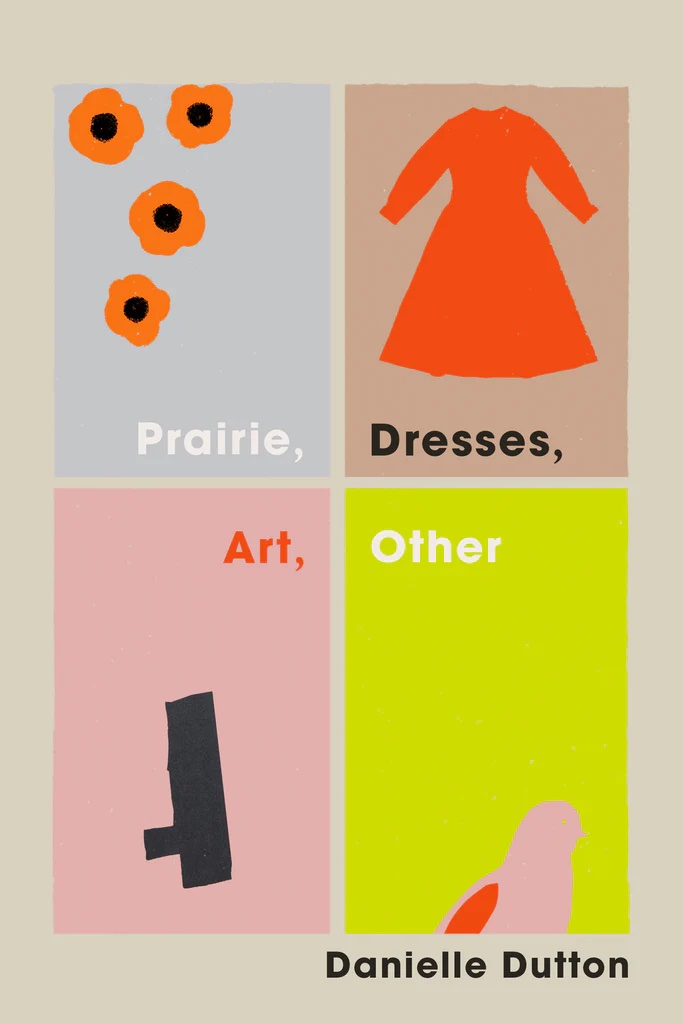REVIEW OF DANIELLE DUTTON’S “PRAIRIE, DRESSES, ART, OTHER”
By Rebecca Valley
Dutton, Danielle. Prairie, Dresses, Art, Other. Coffee House Press, 2024. $17.95
Opening Spaces: A Review of Prairie, Dresses, Art, Other by Danielle Dutton
- PRAIRIE
When I enter Danielle Dutton’s latest book, Prairie, Dresses, Art, Other, the narrator is nameless. In the prairie, only plants and animals have names. And it’s this anonymous “she” that I follow into Dutton’s first fables – stories of mothers, mostly, who find themselves suddenly lost.
Like a fable, it is less about the truth than the atmosphere. Here is the curious child, and here the absentee husband. Here is the campsite, the riverbed, the empty American highway. Here is a hill that appears only occasionally, on quiet evenings, to remind you that one day, you’ll be dead.
She could reach out and touch the trees or the dim projection of trees.
This landscape is haunted. Or, the narrator believes the landscape is haunted. And really, what’s the difference?
Something about moving through time like moving across a thought, or moving through a sentence like hurtling downstream.
Something is wrong in Dutton’s prairie. I find myself looking up from the page just as disoriented as the “she” I am following. What time is it? And have I always been here alone?

- DRESSES
Now I am reading about dresses. Or I am reading Dutton’s catalog of quotations about dresses, numbered and placed beside each other like hangers in a row.
…there were lace curtains behind them, and the chill of the window, and beyond that trees and fields and the wind.
When you read a landscape of dresses, it is easy to forget that you are actually looking at bodies. Bodies in dresses. Bodies in a field.
Here, the texture and color in the sleeve of her dress meld into the pine boughs behind her.
In this collage of borrowed language, am I the dress or the body or the field or the feeling? There is disorientation in being placed unexpectedly inside a moment. Sooner or later she must be subdued into young ladyhood… But who is “she”?
But it is also beautiful to be placed inside a sentence. To create around each dress an imagined before and after. Who wears this dress, and where am I?
You read but you are also writing.
And of course, the intimacy — experiencing, in carefully curated fragments, what Dutton has read. What she wants to give to me.
The morning road air is like a new dress.
- ART
I want to ask: How might fiction be conceived of as a space within which we attend to the world? A way of opening spaces – prairies, paragraphs, rooms – in which a world can occur?
What is it that Dutton is trying to do? The answer seems to be: everything. To create a landscape of language as complex as the landscapes in which we live, and to show us each corner of it. So that for once, we might fully see.
If a story were just like being in a garden, wouldn’t that be amazing?
How much of what we make is a translation of what we experience? This is one of Dutton’s questions. We look at an image, we look at a garden, and translate it in our own language. And isn’t that a kind of conversation we have with art, and with each other?
Meanwhile, in our translations, we are continually estranging ourselves from the original thing. In writing the landscape, we see it more clearly — but we also distance ourselves from it. We make a new, third thing. Our own prairie, entirely distinct.
Dutton said that in her work publishing experimental literature in translation, the exact words were less important than conveying the particular strangeness of the original text. To give the reader the feeling of having read it in its own language.
…that the job of art is to make the world strange, so that we might see it again…
- OTHER
Whenever I’m not writing, which is most of the time, what is it I’m doing?
Sometimes, you read a book that makes you wonder what it is we’re doing here. I mean you and I; the reader, the writer. What is the project of writing if not to make a world, and then show us how to live in it?
One of Bakhtin’s contemporaries said that a book is a machine for thinking. So what kind of machine do we need?
By combining essay and fiction, the real with the imagined, Dutton asks us what it means to create with language. How much of ourselves we place inside our pages. And what we can see of ourselves, looking out from our art.
And if you look hard enough, you’ll see yourself on the page…
How might we, readers, writers, artists, open space for the kind of world we want to live in? How might we open space for loneliness & tenderness & love & rage & fear. How might we place the real and the imagined beside each other. Because they inform each other. Because we look at art to create art to find ourselves in art to find meaning in the world.
Look up. What do you see in the prairie, with wide sky above and around you?
‘Is this still part of the play?’ someone asks.
The sky is blank, the lake a mirror.
Rebecca Valley is a poet living in Durham, North Carolina. Her work has been published in
Black Warrior Review, Bennington Review, Permafrost, Tinderbox Poetry Journal, and
elsewhere. She received her MFA in Poetry from UMass Amherst. Her chapbook, The
Salvageman, was published by o-blek editions in 2022. You can find more of her work at
www.rebeccavalley.com.
